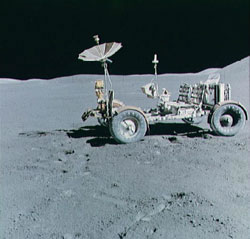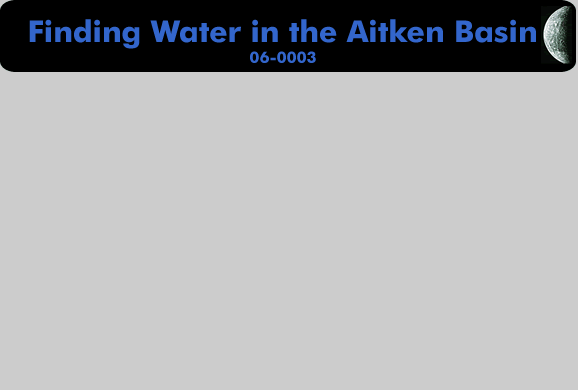MER and Lunar Rovers
What does MER stand for and when, where, and why were they used?
| MER stands for Mars Exploration Rovers. MERs are used on Mars, the fourth planet from the sun and the only other planet that might have life on it. The first MER was called Spirit and was launched on June 10, 2003. The second MER, Opportunity, was launched less than a month later on July 7, 2003 [8]. Both MERs have been in use on Mars for over a year. |  |
| Artist's Concept of Rover on Mars (credit: Maas Digital LLC) http://en.wikipedia.org/wiki/Mars_Exploration_Rover#Aeroshell |
The MER has four main parts that have a total mass of 878 kg (1,935 lbs): 1) the lander, 2) the aeroshell, 3) the cruise stage, and 4) the propellant. [9]
The cruise stage is used for the travel from Earth to Mars. It is approximately 2.65 meters (8.7 feet) in diameter and 1.6 m (5.2 ft) tall. It is made mainly out of aluminum, but the outer ring is covered with solar panels.
The aeroshell is like a protective covering for the lander during the trip to Mars. The aeroshell is made up of two parts, the heat shield, which weighs 78 kg (172 lbs) and the backshell, which weighs 209 kg (742 lbs). The heat shield is the part that keeps the lander safe from intense heat during entry to Mars’ atmosphere. The backshell has the parachute, which helps slow the spacecraft down during entry and landing.
The lander is a shell that protects the rover from the forces of impact. The lander is strong but very light. It is made out of graphite fibers woven into a fabric, titanium, and other composite materials. [10]
Why won’t existing Mars Exploration Rovers work for this project?
A) One reason we can't send the MER robots to the moon is because of the temperature swings there. The MER was built for the temperature of Mars, which is farther from the sun and has a more constant temperature. The average temperature on Mars is –67 degrees Fahrenheit (-55 degrees Celsius and 218 degrees Kelvin) [11] The high on mars is 81 degrees Fahrenheit and the low is -207 degrees Fahrenheit. The high on the moon is 212 degrees Fahrenheit and the low is -279 degrees Fahrenheit. [12]
B) The atmosphere on Mars is mainly carbon dioxide. This atmosphere helps provide a temperature gradient. The moon does not have an atmosphere, so extreme temperature differences can be side by side and are determined by where the sunlight is hitting the moon’s surface.
C) The MER robots are completely dependent on on-board solar power. The Aitken Basin hardly ever receives sunlight so the solar panels on the MER robot would not receive enough sunlight for power.
D) The landing system that the Spirit and Opportunity rovers used will not work on the moon. The MER landed using giant parachutes (released out of the lander after they entered Mars’ atmosphere) to slow it down. When it got closer to the ground, giant balloons inflated around the rover so the impact of the ground would not damage anything. The MER kept bouncing along until it stopped. After it stopped, the balloons deflated and the lander opened up to reveal the rover. This worked on Mars because the Mars terrain was rocky, but had a flatter surface. The moon’s terrain is more torn up by craters and mountains, so it would not be safe to use this landing system [13]. Also, because the moon does not have an atmosphere, the MER parachutes would not have enough resistance to slow down the descent.
Features of the MER that we can use on this mission:
For our Research Rover, one thing we can use from the MER is the drill. The MER uses the Rock Abrasion Tool (RAT) to drill rocks and find water. It uses grinding wheels of diamond dust and resin to gently wear away the rocks on Mars. The RAT is connected to the rover's only arm and is about the size of a soda can, measuring 7 centimeters in diameter and 10 centimeters long. The RAT also uses two brushes to sweep abraded rocks to get them ready for scientific examination. [14] The RAT is used to drill deeper down, past the top part of the rocks. Scientists believe information gathered from deeper sections could reveal how the rocks were formed and what the environment was like when it was formed. [15] This drill technology could be used in this project as well.
We can also use some of the control systems that the MER used. Like the MER, our Research Rover needs to be semi-autonomous, but also have the capability for remote control by the scientists at NASA.
Also, the MER robot used lithium-ion batteries. This would be an efficient way to store the energy used in this project. [16]
The protective Aeroshell could also be used on our Research Rover and Energy Stations because we need to insulate our robot system from the intense temperatures on the moon.
What are the Lunar Rovers and when, where, and why are they used?
| The lunar rovers are rovers that explore the moon. Lunar means anything that has to do with the moon. The first lunar rover, Lunokhod 1, was launched on December 10, 1970. The Lunakhod 1 was a Soviet Union craft. It was the first remote control vehicle to land on another world. [17] |  |
| Image from http://fi.edu/pieces/schutte/LRV.html |
A lunar roving vehicle (LRV) is the small “dune-buggy” vehicle that allows the astronauts to travel from the landing site. It weighs about 480 pounds on Earth and about 80 pounds on the moon (216 kg on the Earth and 36 kg on the Moon). The LRV can carry up to twice its weight (960 pounds) which is good when the astronauts are collecting samples. The LRV is designed, for safety reasons, to go at a low speed but have high torque. The LRV’s tires are made out of wire mesh (similar to piano wire) and are covered with titanium cleats for treads. [18]
Why the Lunar Rovers cannot be used:
Like the MER, the lunar rovers depend on on-board solar power and the Aitken Basin rarely gets sunlight. Also, LRVs are designed for travel and exploration, but not for long term scientific research.
Features of the Lunar Rovers that can be used:
One instrument that is placed on the LRV is a traverse gravimeter. By using a vibrating string accelerometer, it allows the astronauts to map out, record, and read the data of the moon's gravitational field.
The lunar modules are equipped with a rocket motor to slow down the space craft during its descent (landing). It is equipped with another rocket motor that is used to speed up the space craft during its ascent (take off). [19]








